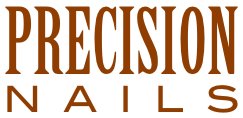Welcome to the Precision Nails Blog
As a salon owner and licensed manicurist, my perspective on the nail industry could not be more practical. While some may be offended by the opinions expressed, please understand that I want to share information and stimulate discussion. Whether you want your nails done or do nails professionally, I hope you find this blog both useful and interesting.
Jaime Schrabeck, Ph.D.
Materials on this website may not be reproduced, redistributed, transmitted, copied, cached, or otherwise used, without prior written consent of Jaime Schrabeck. To request consent, contact Jaime at consulting@precisionnails.com.
Jaime Schrabeck, Ph.D.
Sunday, September 30, 2012
Organizing your Salon Space
Article Published in Stylist Magazine, September 2012
How much space do you really need to do your best work? It may be less than you think. Whether you’re planning a new salon or remodeling an existing one, the size of your space doesn’t matter as much as how it’s organized. A small, individual room can be functional, spacious and luxurious if organized efficiently, whereas a large salon can be impractical, cluttered and cheap-looking if it’s not. Having an efficient salon space can reduce your overhead (lease, utilities, equipment, maintenance, etc.) and increase your productivity.
Before spending any money on decorating, expanding or moving your salon, learn what’s required by your state board. Even if you already have a valid salon/facility/establishment license, it’s worth reviewing the current regulations about equipment, ventilation, flooring, plumbing/toilets, product storage, signage, etc. Some states are more restrictive than others; here are specific examples:
California - a drinking fountain that is accessible to the disabled may be required in new buildings and remodels (check with local authorities).
Ohio - a floor plan drawn to scale and a sign at the main entrance “using at least three inch tall letters.”
Oregon - a list of licensees providing services and “a map or directions to the facility if it is located in a rural or isolated area.”
Texas - an “autoclave, dry heat sterilizer or ultraviolet sanitizer” if providing nail services.
Washington - a public liability insurance policy for at least $100,000.
A complete list of regulations for your state can be found online; if you have any questions or concerns, make sure to get a response in writing before proceeding. Required or not, business insurance (both liability and property) is a worthwhile investment to protect your clients, your salon and its contents.
State board requirements aside, your salon environment reflects more than personal style (design choices, color preferences, etc.); it also reflects your priorities, which transcend style. Your first priority should be to protect the health and safety of clients. That’s why cleanliness is so important. There’s no excuse for a dirty salon, except the obvious: the busier you are, the more cleaning needs to be done (dusting!), and the less time you have to do it. That’s all the more reason to simplify your decor, have adequate cleaning supplies available and develop a quick routine for surface cleaning. Sharing the responsibility for cleaning will encourage everyone to do their part and take pride in the salon environment. Deeper cleaning also needs to be done on a regular basis, either by staff or an outside service.
Another priority in your salon should be client comfort. Clients are more likely to enjoy their experience when they feel safe and trust your professionalism. Consider your clients as they transition from one aspect of your salon to another. From reception and services, to retail and restrooms, your space needs to be sensible, convenient and accessible, in addition to being clean. Furthermore, the operation of your salon should seem effortless; for example, clients shouldn’t be able to see business paperwork (invoices, bills, bank statements, etc.). To reduce paper clutter, sort through your mail right away, recycle unwanted catalogs, shred sensitive materials and store your paperwork somewhere other than the salon, if possible.
Your comfort as a service provider cannot be neglected either. Because you’ll be spending most of your time at your station, it has to be designed ergonomically. Supportive seating, proper body positioning and adequate task lighting are a must. To conserve space, I’ve created stations where hand and foot services can be performed simultaneously, rather than have separate manicure/enhancement and pedicure areas. Because my salon provides “waterless” services, the only plumbing necessary is a sink where clients and manicurists wash their hands, tools are processed for the autoclave sterilizer and towels can be moistened before placing in the warmer. The public restrooms are conveniently located just outside the front door and maintained by the management of the shopping center.
Contrary to how most manicurists design their stations, every product or piece of equipment does not need to be within arms reach. In fact, it’s better for your health to stand up and move periodically. In my salon, each station has a compact rolling cart stocked with the products used most often during services (gloves, files, cuticle remover, base coat, top coat, etc.); bulk quantities of those same products, the extensive polish/gel polish selection and equipment (towel warmer, paraffin warmer, microwave, etc.) are stored in the back room. Plastic containers and a label maker can keep your back room, or any storage area, organized and clean.
Speaking of storage, do yourself a favor and dispose of products you rarely or never use. Minimizing your products will reduce clutter in your salon, and focus resources (money and space) on the most important ones. Buying those products in bulk, which I strongly recommend, doesn’t require that everything be stored at the salon. For example, I buy nearly 500 lbs. of paraffin (packaged in 24 lb. cases) every two years; I can store the paraffin at home and bring a case to the salon about once a month. Whatever space you utilize, ensure that you store products safely (follow manufacturer’s instructions) and have corresponding MSDS (Material Safety Data Sheets) available for reference.
By Jaime Schrabeck, Ph.D.
Subscribe to:
Post Comments (Atom)





No comments:
Post a Comment